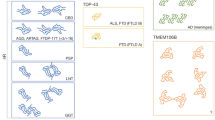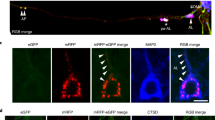Abstract
Drosophila melanogaster is emerging as an important model system for neurodegenerative disease research. In this protocol, we describe an efficient method for imaging amyloid deposits in the Drosophila brain, by the use of a luminescent-conjugated oligothiophene (LCO), p-FTAA polymer probe. We also demonstrate the feasibility of co-staining with antibodies and compare the LCO staining with standard amyloid-specific probes. The LCO protocol enables high-resolution imaging of several different protein aggregates, such as Aβ1-42, Aβ1-42E22G, Transthyretin V30M and human Tau, in the Drosophila brain. Aβ and Tau aggregates could also be distinguished from each other because of distinct LCO emission spectra. Furthermore, this protocol enables three-dimensional brain mapping of amyloid distribution in whole-mount Drosophila brains. The use of p-FTAA combined with other probes, antibodies and/or dyes will aid the rapid characterization of various amyloid deposits in the rapidly growing number of Drosophila models of neurodegenerative diseases.
This is a preview of subscription content, access via your institution
Access options
Subscribe to this journal
Receive 12 print issues and online access
$259.00 per year
only $21.58 per issue
Buy this article
- Purchase on SpringerLink
- Instant access to full article PDF
Prices may be subject to local taxes which are calculated during checkout




Similar content being viewed by others
References
Crowther, D.C. et al. Intraneuronal abeta, non-amyloid aggregates and neurodegeneration in a Drosophila model of Alzheimer's disease. Neuroscience 132, 123–135 (2005).
Wittmann, C.W. et al. Tauopathy in Drosophila: neurodegeneration without neurofibrillary tangles. Science 293, 711–714 (2001).
Jackson, G.R. et al. Polyglutamine-expanded human huntingtin transgenes induce degeneration of Drosophila photoreceptor neurons. Neuron 21, 633–642 (1998).
Pokrzywa, M., Dacklin, I., Hultmark, D. & Lundgren, E. Misfolded transthyretin causes behavioral changes in a Drosophila model for transthyretin-associated amyloidosis. Eur. J. Neurosci. 26, 913–924 (2007).
Berg, I., Thor, S. & Hammarstrom, P. Modeling familial amyloidotic polyneuropathy (Transthyretin V30M) in Drosophila melanogaster. Neurodegener. Dis. 6, 127–138 (2009).
Greeve, I. et al. Age-dependent neurodegeneration and Alzheimer-amyloid plaque formation in transgenic Drosophila. J. Neurosci. 24, 3899–3906 (2004).
Iijima, K. et al. Abeta42 mutants with different aggregation profiles induce distinct pathologies in Drosophila. PloS One 3, e1703 (2008).
Nilsson, K.P.R., Herland, A., Hammarstrom, P. & Inganas, O. Conjugated polyelectrolytes: conformation-sensitive optical probes for detection of amyloid fibril formation. Biochemistry 44, 3718–3724 (2005).
Nilsson, K.P.R. et al. Imaging distinct conformational states of amyloid-beta fibrils in Alzheimer's disease using novel luminescent probes. ACS Chem. Biol. 2, 553–560 (2007).
Åslund, A. et al. Novel pentameric thiophene derivatives for in vitro and in vivo optical imaging of a plethora of protein aggregates in cerebral amyloidoses. ACS Chem. Biol. 4, 673–684 (2009).
Sigurdson, C.J. et al. Prion strain discrimination using luminescent conjugated polymers. Nat. Meth. 4, 1023–1030 (2007).
Brand, A.H. & Perrimon, N. Targeted gene expression as a means of altering cell fates and generating dominant phenotypes. Development 118, 401–415 (1993).
Åslund, A., Nilsson, K.P.R. & Konradsson, P. Synthesis of a pentathiophene fluorescent probe, 4′,3″′-bis-carboxymethyl-[2,2′;5′,2″;5″,2″′;5″′,2″″]quinquethiophene-5,5″″-dicarboxylic acid (p-FTAA). Nat. Protoc. Netw. DOI: 10.1038/nprot.2010.24 (2010).
Lin, D.M. & Goodman, C.S. Ectopic and increased expression of Fasciclin II alters motoneuron growth cone guidance. Neuron 13, 507–523 (1994).
Acknowledgements
We are grateful to Damian Crowther for the kind gift of the UAS-Aβ1-42E22G and UAS-Aβ1-42 and to Mel B. Feany for the gift of the UAS-Tau flies. We thank the division of Pathology at the University of Linköping for the kind gift of the ToPro3 solution and for the excellent technical support by Magnus Baumgardt and Mattias Alenius at the division of Molecular Genetics at the Univerity of Linköping. A special thank to Andreas Åslund at the division of Organic Chemistry of Linköping University for the contribution of p-FTAA. This work was supported by a generous gift from Astrid and Georg Olsson (P.H. and K.P.R.N.), the Swedish Foundation for Strategic Research (S.T., K.P.R.N. and P.H.), 'Hjärnfonden' (S.T.), The Knut and Alice Wallenberg foundation (S.T., K.P.R.N. and P.H.), and the Swedish Research Council (S.T. and P.H.). P.H. and S.T. are Swedish Royal Academy of Science Research Fellows sponsored by a grant from the Knut and Alice Wallenberg Foundation.
Author information
Authors and Affiliations
Contributions
I.B., K.P.R.N., S.T. and P.H. designed the research; I.B. carried out the research; I.B., K.P.R.N. and P.H. analyzed data; and I.B. and P.H. wrote the paper.
Corresponding author
Ethics declarations
Competing interests
The authors declare no competing financial interests.
Rights and permissions
About this article
Cite this article
Berg, I., Nilsson, K., Thor, S. et al. Efficient imaging of amyloid deposits in Drosophila models of human amyloidoses. Nat Protoc 5, 935–944 (2010). https://doi.org/10.1038/nprot.2010.41
Published:
Issue Date:
DOI: https://doi.org/10.1038/nprot.2010.41
This article is cited by
-
Preparation of near-infrared AIEgen-active fluorescent probes for mapping amyloid-β plaques in brain tissues and living mice
Nature Protocols (2023)
-
MicroRNA-195 rescues ApoE4-induced cognitive deficits and lysosomal defects in Alzheimer’s disease pathogenesis
Molecular Psychiatry (2021)
-
Moving bed biofilm reactor developed with special microbial seed for denitrification of high nitrate containing wastewater
World Journal of Microbiology and Biotechnology (2021)
-
Amyloid protein produced by B. cereus CR4 possesses bioflocculant activity and has potential application in microalgae harvest
Biotechnology Letters (2020)
-
Substantial fibrin amyloidogenesis in type 2 diabetes assessed using amyloid-selective fluorescent stains
Cardiovascular Diabetology (2017)
Comments
By submitting a comment you agree to abide by our Terms and Community Guidelines. If you find something abusive or that does not comply with our terms or guidelines please flag it as inappropriate.



